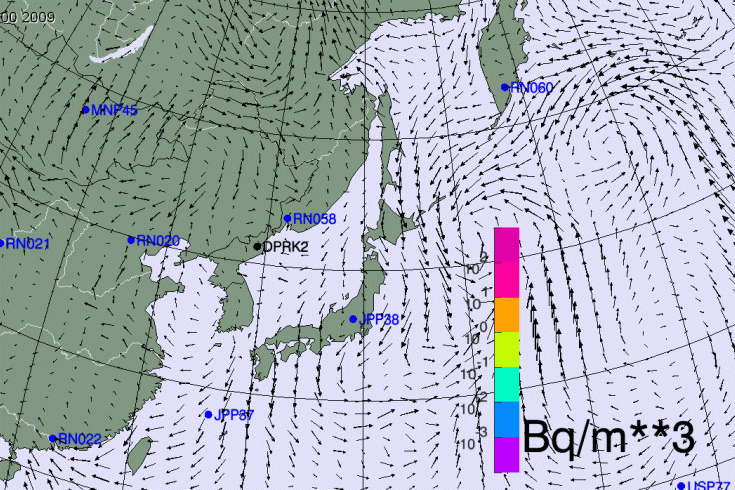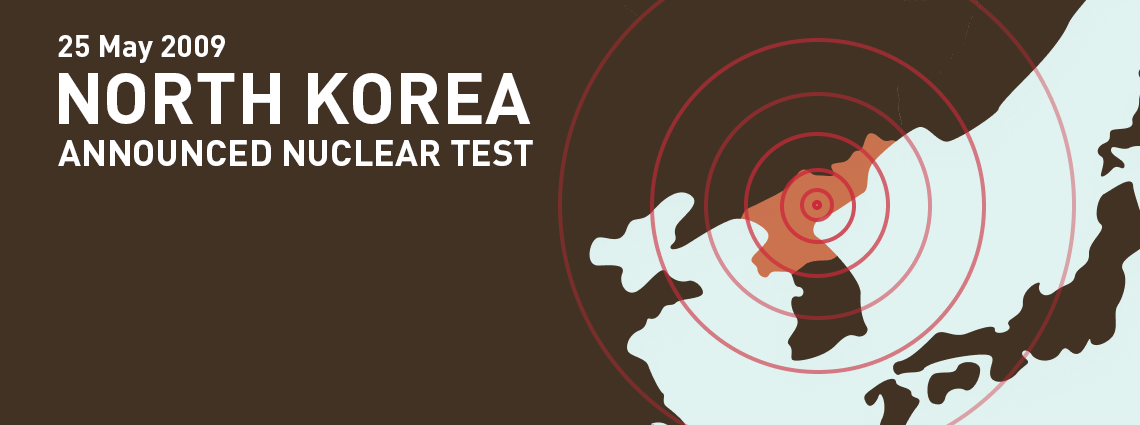2009 DPRK Announced Nuclear Test
Overview: DPRK 2009 announced test
Learn more
Press Conference audio
Press conference audio .mp3

Technical findings
The Democratic People’s Republic of Korea (DPRK) claimed earlier today, 25 May 2009, that it had conducted a nuclear test. The Executive Secretary of the Preparatory Commission of the Comprehensive Nuclear-Test-Ban Treaty Organization (CTBTO), Tibor Tóth, has deplored the DPRK’s action as “a serious violation of the norm established by the Comprehensive Nuclear-Test-Ban Treaty (CTBT) and as such deserves universal condemnation”.
The International Monitoring System's seismic stations registered a seismic event; at 41.2896 degrees North and 129.0480 degrees East at 00:54:43 GMT (09:54 local time). The signal’s area of origin is largely identical with the 2006 DPRK nuclear test. CTBTO Member States received the first automatic estimation of time, location and magnitude of the event at 2:24 GMT - before the DPRK announced the test. More precise estimations were distributed two and four hours later.
Higher magnitude than in 2006
The event’s magnitude is slightly higher than in 2006, measuring 4.52 on the Richter scale, while in 2006 it was 4.1. Considerably more seismic stations picked up the signal this time: 23 primary seismic stations compared to 13 in 2006; the closest IMS station to the event was at Ussuriysk, Russia, and the furthest in Texas, USA – halfway around the world. Since the last DPRK nuclear test, the number of seismic stations in the IMS network has increased from 89 to 130. Overall, three-quarters or 75 percent of the 337 facilities in the International Monitoring System are already in place.
Only after further analysis at the International Data Centre in Vienna, using data from the 16 auxiliary seismic stations that recorded the event as well, will it be possible to confirm that the signal was manmade and not an earthquake.
Nuclear character yet to be established
Once the manmade character has been established, the next step will be to detect radioactive particulates or noble gases that are frequently released into the atmosphere even by underground nuclear tests. In October 2006, traces of the noble gas xenon 133 took two weeks before being detected by one of the IMS’s stations in Yellowknife, Canada; 7,500 km away. While the noble gas network consisted of only 10 systems then, there are 22 today (out of a total of 40 when the network is complete). Some of the new stations are situated close to the DPRK, in China, Japan and Russia. While the exact meteorological situation will determine how long it will take for these stations to detect radioactive noble gases, the period of time is likely to be shorter than in 2006.
On-site inspection would be possible
If the CTBT were in force, an on-site inspection could be dispatched to corroborate the findings and present them to its Member States to pronounce the final verdict. An on-site-inspection will only be possible after the CTBT has entered into force. However, the initial seismic findings of today’s event have already homed in on it precisely enough to request an on-site inspection under the Treaty’s rules. These foresee that an area for an on-site inspection must be no larger than 1,000 km². At the first stage of analyzing the available seismic data, the potential area of origin of today’s event could already be narrowed down to 860 km² - roughly the size of the city of Berlin – and will further decrease significantly in the coming days. The CTBTO has often trained its ability to conduct on-site inspections, most recently in a major exercise at the former Soviet Union nuclear test site Semipalatinsk in September 2008 during the so-called Integrated Field Exercise 2008.
Only nine ratifications missing for entry into force
The 2006 DPRK nuclear test was condemned by the U.N. Security Council as “a clear threat to international peace and security” through resolution 1718. When the CTBT enters into force, the norm against nuclear testing will be considerably strengthened, as a nuclear test will then constitute a breach of international treaty law. Nine countries have yet to ratify the Treaty to that effect: China, Egypt, Indonesia, Iran, Israel and the United States, who have already signed the Treaty, whereas the DPRK, India and Pakistan have not yet signed it. 180 States worldwide have signed the CTBT, of which 148 have ratified; see interactive map.
Press Centre
12 June 2009
Experts sure about nature of the DPRK event
10 June 2009
CTBTO commended on swift action to DPRK nuclear test
29 May 2009
Homing in on the event
27 May 2009
Next phase in the analysis of the announced DPRK nuclear test
26 May 2009
CTBT States Signatories meet to consider DPRK announced nuclear test
25 May 2009
CTBTO's initial findings on the DPRK announced nuclear test
25 May 2009
Statement by CTBTO Chairman Ambassador Peter Shannon on the announced DPRK nuclear test
25 May 2009
Statement by Tibor Toth, CTBTO Executive Secretary on the announced DPRK nuclear test
